SNEAK ATTACK SAVAGES U.S. PACIFIC FLEET
Pearl Harbor, Hawaii · December 7, 1941
On this date in 1941, a quiet Sunday morning on the Hawaiian island of Oahu just before 8 o’clock, Japan staged an unprovoked attack on America’s doorstep, the U.S. naval base at Pearl Harbor and its defending Army Air Corps and Marine airfields dotting the harbor perimeter. Twelve days earlier, on November 26, over 30 vessels of the Japanese First Air Fleet, including six aircraft carriers with over 420 embarked planes, left Japanese waters on a 3,400‑mile journey for a point 250 miles north of the Hawaiian Islands. The most powerful carrier task force ever assembled sailed into history under the command of 58‑year‑old Vice Adm. Chūichi Nagumo. On December 1, Tokyo sent Nagumo the coded signal to bomb Pearl Harbor. By the afternoon of December 7, 1941—the Day of Infamy, as President Franklin D. Roosevelt called it—the heart of the American Pacific fleet lay burning or settled on the bottom of the harbor, among them eight great battleships. (By sheer good fortune, the fleet’s aircraft carriers, which soon would play a decisive role in turning the tide against Japan at the Battle of Midway the following June, were at sea.) Over 3,500 U.S. sailors, Marines, airmen, soldiers, and civilians lay dead, many of them entombed for eternity in ships such as the USS Arizona and USS Utah; another 1,178 were wounded. More than 340 Army and Navy aircraft were destroyed or damaged. On the Japanese side, losses were modest: 64 airmen killed, 5 ships sunk, and 29 planes destroyed. The surprise attack 73 years ago began a nonstop onslaught of Japanese conquests that brought down American, British, French, and Dutch flags throughout Southeast Asia and the Pacific. Yes, Pearl Harbor was the most devastating military assault in American history and a stunning tactical victory for the Japanese militarists. But Pearl Harbor also spelled Japan’s doom, just like Adolf Hitler’s and Benito Mussolini’s declarations of war against the U.S. four days later effectively spelled their countries’ doom. The aroused U.S., with deep pockets of wealth, industrial power, and prospective military strength, was now allied with tiny embattled Great Britain against the ambitious and authoritarian despots in Tokyo, Berlin, and Rome. Within three years, U.S. forces were knocking down the doors of Japan’s and Germany’s home fortresses to their nations’ grief.
[amazon_carousel widget_type=”ASINList” width=”600″ height=”200″ title=”Recommended Reading” market_place=”US” shuffle_products=”False” show_border=”False” asin=”0737000996,0465021395,0300154453,0805068031,161200010X,0465089828,1574882228,0345446070,1617564125,1933550333″ /]
Pearl Harbor, December 7, 1941, the Day of Infamy
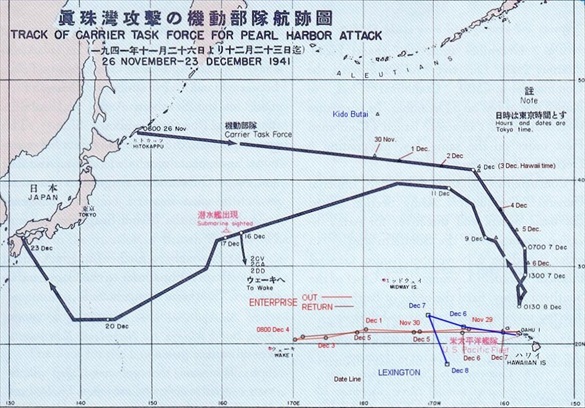 |
Above: Route of the Japanese Pearl Harbor Striking Force to and from Pearl Harbor (bold black). Routes of U.S. carriers Enterprise (red) and Lexington (blue) in early December are shown to the left of the Hawaiian Islands. After launching its air and sea attack on Pearl Harbor with overwhelming force, the Japanese carrier task force sailed away undetected and virtually unscathed.
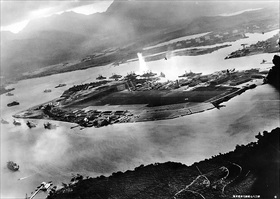 | 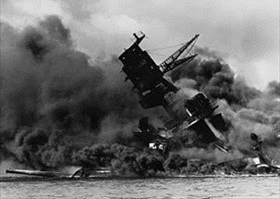 |
Left: Photograph from a Japanese plane of Pearl Harbor’s Battleship Row at the beginning of the attack. The explosion in the center is a torpedo strike on the USS Oklahoma. Two attacking Japanese planes can be seen—one over the USS Neosho, a fleet oiler, and one over the Naval Yard. Of eight battleships in the harbor, the attack destroyed the USS Arizona; two, the USS California and the USS West Virginia, were sunk at their moorings; the USS Oklahoma capsized; the USS Nevada was forced to beach; and three were damaged but remained afloat. Additionally, the attack severely damaged nine other warships, destroyed 188 aircraft, and killed 2,335 U.S. servicemen and 68 civilians. The greatest loss of life occurred aboard the USS Arizona, which lost 1,177 sailors and Marines; just 335 men survived the attack.
![]()
Right: Hit by an armor-piercing bomb, the forward magazines of the USS Arizona exploded, sending the battleship to the harbor bottom just 14 minutes after the Japanese attack began. The supporting structure of the forward tripod mast collapsed after the magazine exploded. The dead—sailors and Marines—numbered 1,177. The ship burned for two days. Today the sunken Arizona is a war memorial that commemorates the “initial defeat and ultimate victory” of all lives lost on December 7, 1941.
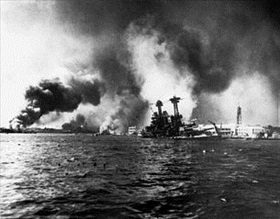 | 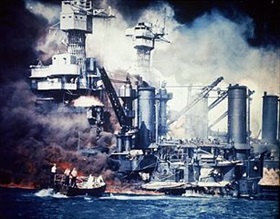 |
Left: The battleship USS California is seen slowly sinking alongside Ford Island, Pearl Harbor, as a result of bomb and torpedo damage that killed 100. The destroyer USS Shaw burns in the floating dry dock in the left distance. The battleship USS Nevada is beached in the left-center distance, having lost 60 men in the attack. The California returned to service in January 1944, the Shaw in June 1942, and the Nevada in October 1942.
![]()
Right: The battleship USS West Virginia took two aerial bombs, both duds, and seven torpedo hits, one of which may have come from a Japanese midget submarine. Sailors in a motor launch are pictured rescuing a survivor from the water alongside the sunken ship during or shortly after the attack, which killed 106 men. The West Virginia returned to service in July 1944. The battleship USS Tennessee, which lost five seamen in the attack, is visible behind the West Virginia. The Tennessee returned to service February 1942.
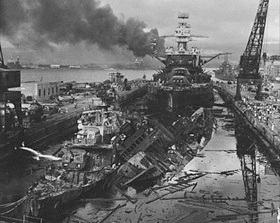 | 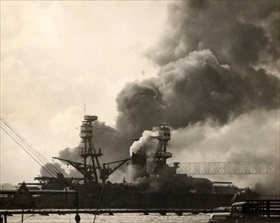 |
Left: Admiral Husband E. Kimmel’s flagship, the battleship USS Pennsylvania, can be seen in dry dock behind the wrecked destroyers USS Downes and USS Cassin at the Pearl Harbor Navy Yard soon after the end of the Japanese air attack. The Cassin capsized against the Downes. The torpedo-damaged cruiser USS Helena can be seen in the right distance beyond the crane. In the center distance is the capsized Oklahoma with the USS Maryland alongside. The smoke is from the sunken and burning Arizona, out of view behind the Pennsylvania. The California is partially visible at the extreme left. The Pennsylvania, which lost five men, remained in service.
![]()
Right: Hit by six bombs and one torpedo, which killed 60 men, the battleship USS Nevada is seen attempting to escape from the harbor. The crew beached the ship, which returned to service in October 1942.
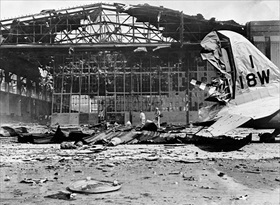 | 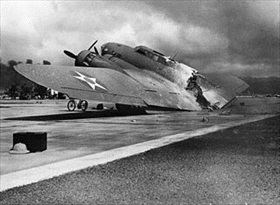 |
Left: Japanese aircrews bombed and strafed Navy air bases at Kaneohe Bay and Ford Island, in the center of Pearl Harbor; Army Air Corps fields at Bellows, Wheeler, and Hickam (shown here); and the Ewa Marine airfield. A total of 188 aircraft were destroyed and 159 damaged.
![]()
Right: A destroyed U.S. Army Air Forces Boeing B-17C Flying Fortress rests near a hangar at Hickam Field, December 7, 1941. Flown from California to Hickam, it arrived during the attack. On its final approach, the aircraft’s magnesium flare box was hit by Japanese strafing and ignited. The burning plane separated upon landing. The crew survived the crash.
Frank Capra’s “Why We Fight,” U.S. Government World War II Propaganda Series
![]()

 History buffs, there is good news! The Daily Chronicles of World War II is now available as an ebook for $4.99 on Amazon.com. Containing a year’s worth of dated entries from this website, the ebook brings the story of this tumultuous era to life in a compelling, authoritative, and succinct manner. Featuring inventive navigation aids, the ebook enables readers to instantly move forward or backward by month and date to different dated entries. Simple and elegant! Click
History buffs, there is good news! The Daily Chronicles of World War II is now available as an ebook for $4.99 on Amazon.com. Containing a year’s worth of dated entries from this website, the ebook brings the story of this tumultuous era to life in a compelling, authoritative, and succinct manner. Featuring inventive navigation aids, the ebook enables readers to instantly move forward or backward by month and date to different dated entries. Simple and elegant! Click 











